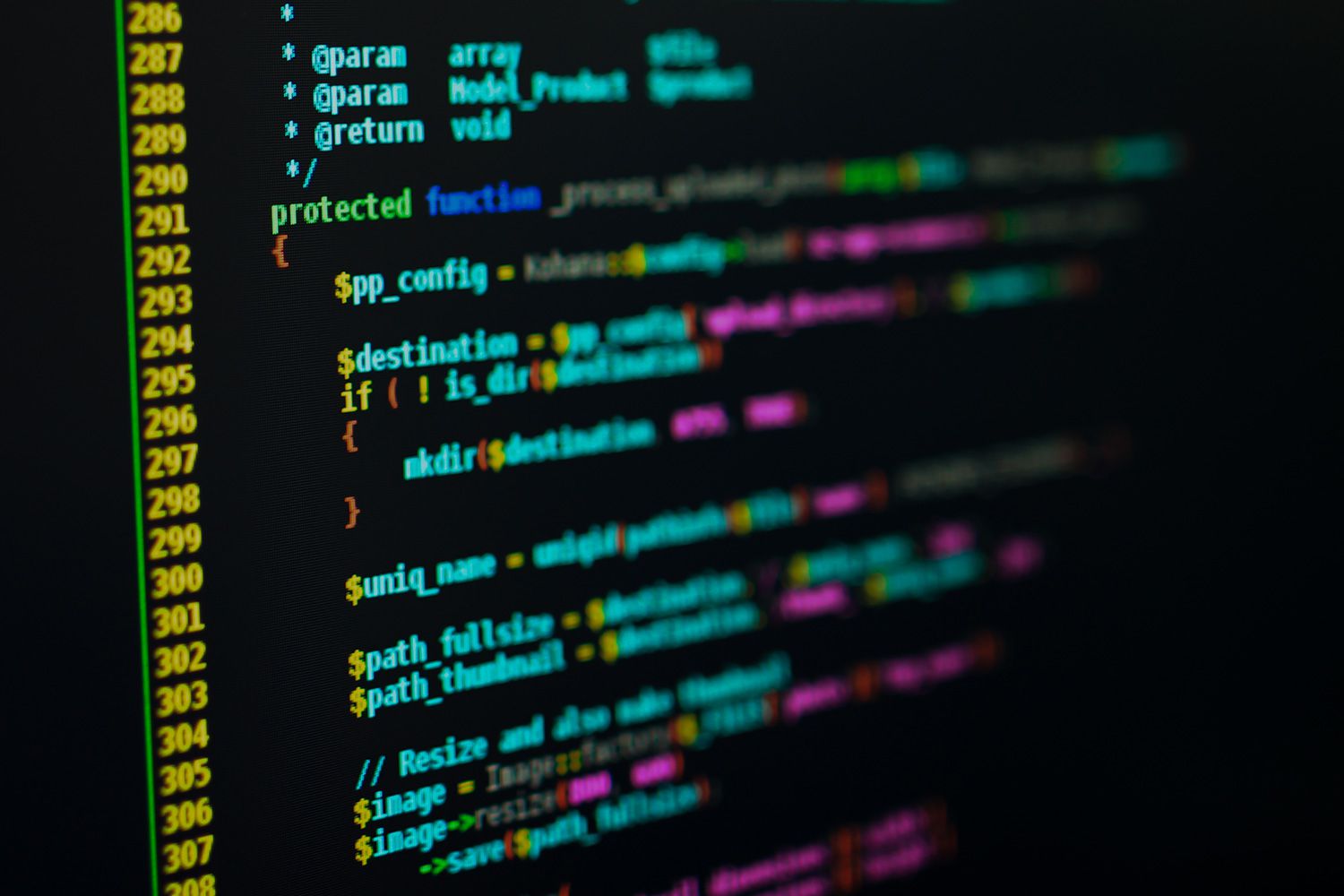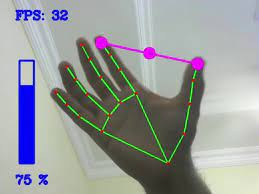Pythonda imo-ishoralar yordamida ovoz balandligini boshqarish
Ushbu maqolada men OpenCV Python kutubxonasidan bir imkoniyat haqida yozmoqchiman. To’liq kodni Github-da ko’rishingiz mumkin.
Maqsad imo-ishoralar yordamida kompyuterdagi ovoz balandligini o’zgartirish. Ovoz balandligi ko’rsatgich va bosh barmoq orasidagi masofa bilan boshqariladi va egilgan kichik barmoq tasdiqlash uchun signal bo’ladi.
Avvalo, barcha kerakli kutubxonalarni o’rnatib oling:
pip install mediapipe pip install opencv-python pip install numpy pip install pycaw
hand_tracking_module.py nomi bilan fayl hosil qiling va quyidagi kodni yozing:
import cv2 import mediapipe as mp import time import math class handDetector(): def __init__(self, mode=False, maxHands=2, modelComplexity=1, detectionCon=0.5, trackCon=0.5): self.mode = mode self.maxHands = maxHands self.modelComplexity = modelComplexity self.detectionCon = detectionCon self.trackCon = trackCon self.mpHands = mp.solutions.hands self.hands = self.mpHands.Hands(self.mode, self.maxHands, self.modelComplexity, self.detectionCon, self.trackCon) self.mpDraw = mp.solutions.drawing_utils self.tipIds = [4, 8, 12, 16, 20] def findHands(self, img, draw: True): imgRGB = cv2.cvtColor(img, cv2.COLOR_BGR2RGB) self.results = self.hands.process(imgRGB) if self.results.multi_hand_landmarks: for handLms in self.results.multi_hand_landmarks: if draw: self.mpDraw.draw_landmarks(img, handLms, self.mpHands.HAND_CONNECTIONS) return img def findPosition(self, img, handNo=0, draw=True): xList = [] yList = [] bbox = [] self.lmList = [] if self.results.multi_hand_landmarks: myHand = self.results.multi_hand_landmarks[handNo] for id, lm in enumerate(myHand.landmark): #print(id, lm) h, w, c = img.shape cx, cy = int(lm.x*w), int(lm.y*h) xList.append(cx) yList.append(cy) self.lmList.append([id, cx, cy]) if draw: cv2.circle(img, (cx, cy), 5, (255,0,255), cv2.FILLED) xmin, xmax = min(xList), max(xList) ymin, ymax = min(yList), max(yList) bbox = xmin, ymin, xmax, ymax if draw: cv2.rectangle(img, (bbox[0]-20, bbox[1]-20), (bbox[2]+20, bbox[3]+20), (0, 255, 0), 2) return self.lmList, bbox def findDistance(self, p1, p2, img, draw=True): x1, y1 = self.lmList[p1][1], self.lmList[p1][2] x2, y2 = self.lmList[p2][1], self.lmList[p2][2] cx, cy = (x1+x2)//2, (y1+y2)//2 if draw: cv2.circle(img, (x1,y1), 15, (255,0,255), cv2.FILLED) cv2.circle(img, (x2,y2), 15, (255,0,255), cv2.FILLED) cv2.line(img, (x1,y1), (x2,y2), (255,0,255), 3) cv2.circle(img, (cx,cy), 15, (255,0,255), cv2.FILLED) length = math.hypot(x2-x1, y2-y1) return length, img, [x1, y1, x2, y2, cx, cy] def fingersUp(self): fingers = [] # Thumb if self.lmList[self.tipIds[0]][1]Agar yaxshilab ushbu class nima qilishi haqida bosh qotirsangiz unda hech qanday qiyin ishlar yo'qligini va barchasi oson ekanini tushunasiz.
Endi dasturni asosiy qisimi yozishni boshlaymiz.
Kerakli narsalarni kodga import qilishdan boshlaymiz
import cv2 import time import numpy as np import HandTrackingModule as htm import math from ctypes import cast, POINTER from comtypes import CLSCTX_ALL from pycaw.pycaw import AudioUtilities, IAudioEndpointVolume Kamera sozmalari : wCam, hCam = 1280, 720 # размер окна cap = cv2.VideoCapture(0) cap.set(3, wCam) cap.set(4, hCam) pTime = 0Kamerani ulashda xatoliklar yuz berishi mumkin, 0 ni `cap = cv2.VideoCapture(0)` dan 1 yoki 2 ga o'zgartiring.
Global o'zgaruvchilarni belgilaymiz:
detector = htm.handDetector(detectionCon=0.7, maxHands=1) devices = AudioUtilities.GetSpeakers() interface = devices.Activate(IAudioEndpointVolume._iid_, CLSCTX_ALL, None) volume = cast(interface, POINTER(IAudioEndpointVolume)) volRange = volume.GetVolumeRange() volume.SetMasterVolumeLevel(0, None) minVol = volRange[0] maxVol = volRange[1] vol = 0 volBar = 400 volPer = 0 area = 0 colorVol = (255, 0, 0)Biz cheksiz tsiklni boshlaymiz va kameradan tasvirni olishga harakat qilamiz.
_, img = cap.read()Qo'limizni ramkada topamiz va uni belgilaymiz:
img = detector.findHands(img) lmList, bbox = detector.findPosition(img, draw=True)Qo'lni tanlashga hojat bo'lmaganlar uchun draw=True ni False ga o'zgartiring.
Agar lmList ro'yxati bo'sh bo'lmasa, biz ko'rsatgich va bosh barmoq orasidagi masofani hisoblashimiz mumkin. Buning uchun findDistance methodi yuqorida tavsiflangan handDetector classida amalga oshiriladi.
length, img, lineInfo = detector.findDistance(4, 8, img)Agar biz buni shunday qoldirsak, ovoz balandligini o'zgartirish to'g'ri ishlamaydi, shuning uchun siz qabul qilingan parametrlarni o'zgartirishingiz kerak:
# Convert Volume volBar = np.interp(length, [50,200], [400, 150]) volPer = np.interp(length, [50,200], [0, 100])Oxirgi qadam tovush balandligidagi o'zgarishlarni tasdiqlash uchun kichik barmoqning egilganligini aniqlash bo'ladi.
Biz barcha barmoqlarning holatini quyidagicha olamiz:
ingers = detector.fingersUp()Agar kichkina barmoq egilgan bo'lsa, ovoz balandligini o'zgartiladi:
if not fingers[4]: volume.SetMasterVolumeLevelScalar(volPer/100, None)
To'liq kodni mening Github'imda topish mumkin. Bu mening birinchi maqolam va birinchi OpenCV loyihalarimdan biri, shuning uchun juda qattiq muhokama qilmang =)
Umumiy Dasturlash
Pythonda imo-ishoralar yordamida ovoz balandligini boshqarish

